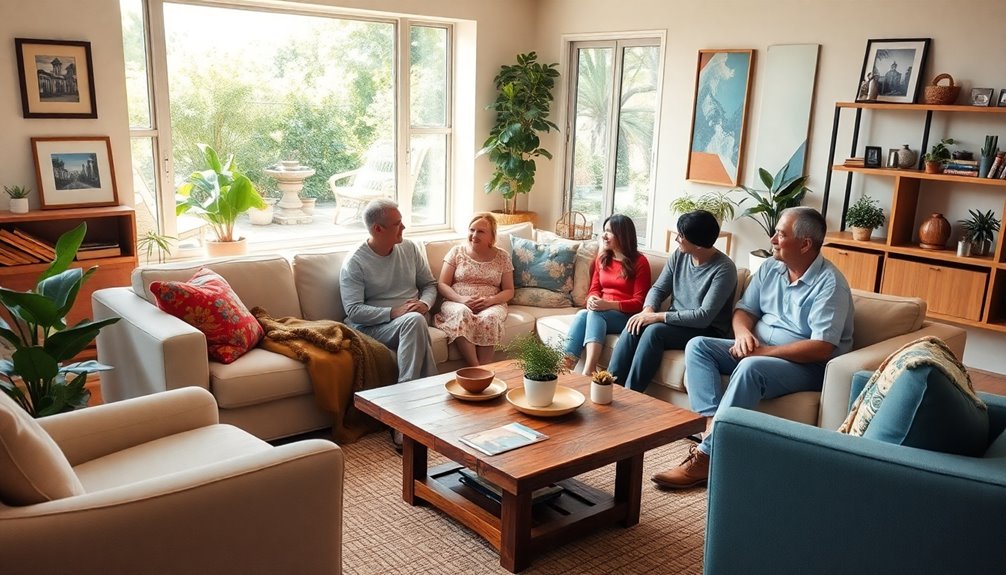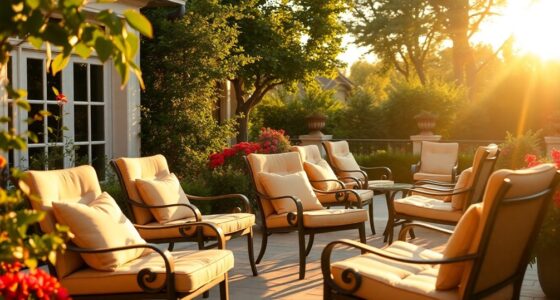To create a harmonious multigenerational home, start by guaranteeing privacy and independence with separate living spaces. Design flexible areas that adapt to changing needs, and prioritize accessibility features for safety. Incorporate outdoor spaces for family bonding through activities like gardening. Personalize areas to reflect individual styles and guarantee efficient kitchen designs for larger households. Finally, foster open communication among family members to strengthen emotional ties. Discover more strategies to enhance your multigenerational living experience.
Key Takeaways
- Design private living spaces with separate entrances and bedroom suites to ensure independence while promoting family interaction.
- Incorporate flexible, multifunctional rooms that adapt to changing family needs and activities, enhancing usability.
- Ensure accessibility features, like curbless showers and grab bars, create a safe environment for all age groups.
- Utilize noise control measures, such as acoustic treatments, to maintain a harmonious atmosphere in shared living spaces.
- Foster outdoor areas with accessible pathways and designated activity zones to encourage family bonding through shared experiences.
Understanding Multi-generational Living
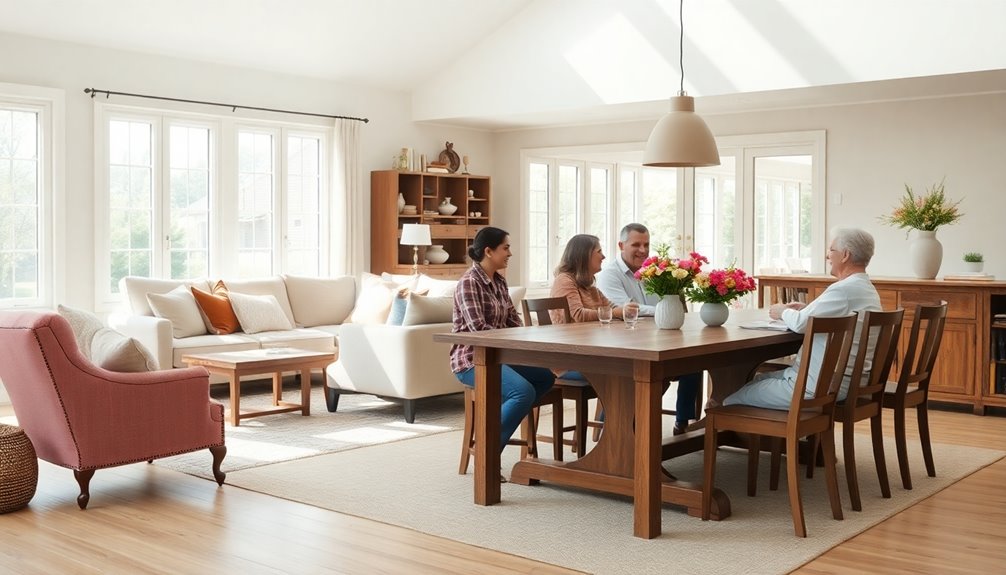
As more families embrace the idea of living together, understanding multi-generational living becomes essential. This arrangement brings together family members spanning generations—children, parents, and grandparents—under one roof.
With over 50 million Americans living in multi-generational households, this trend reflects a response to rising housing costs and a desire for financial efficiency. By sharing living expenses, families can enhance their overall well-being.
Multi-generational living also addresses diverse needs, allowing for integrated elder care and childcare, which strengthens emotional bonds and support systems. This setup fosters mutual learning and enhances quality of life for everyone involved, creating a nurturing environment where family members thrive together. Additionally, engaging in shared financial planning can help families make informed decisions about their collective resources and savings.
Embracing this lifestyle can lead to richer family connections and a supportive home.
The Rise of Multi-Generational Living

You might've noticed that more families are choosing to live together these days, and it's not just for convenience.
The economic benefits, like sharing expenses and childcare, make this arrangement appealing, while the emotional support across generations strengthens family bonds.
As this trend continues to grow, home designs are adapting to meet the unique needs of these co-living situations.
Economic Benefits of Co-Living
The rise of multigenerational living has led to a notable 10% increase in multigenerational households in the U.S. since 2007. This trend highlights the economic benefits of shared living arrangements, particularly for families seeking financial savings.
With over 50 million Americans living in multigenerational setups, many can pool resources effectively. By sharing costs for housing, utilities, and childcare, these households considerably reduce living expenses.
Working parents especially find relief from childcare costs when grandparents pitch in, creating a more balanced work-life dynamic. Additionally, the financial efficiencies gained from co-living arrangements allow families to allocate funds to other essential areas, enhancing their overall quality of life.
Moreover, families can also benefit from understanding state taxes on IRA withdrawals, which can further enhance their long-term financial planning. Embracing multigenerational living isn't just practical; it's a smart financial strategy.
Emotional Support Across Generations
While many families face the challenges of modern life, multigenerational living offers a unique solution that fosters emotional support across generations.
With over 50 million Americans living in these arrangements, you'll find that sharing a home creates deeper bonds and mutual learning opportunities.
By integrating elder care and childcare, your family can navigate changing needs together, ensuring everyone feels valued and supported.
This setup not only enhances emotional well-being but also encourages quality time, allowing you to create lasting memories.
As you share experiences, you'll cultivate a sense of belonging that strengthens family ties.
Embracing this lifestyle helps you navigate life's complexities while nurturing emotional connections across all ages. Additionally, practicing self-care techniques can further enhance the emotional well-being of all family members involved.
Designing for Privacy and Independence
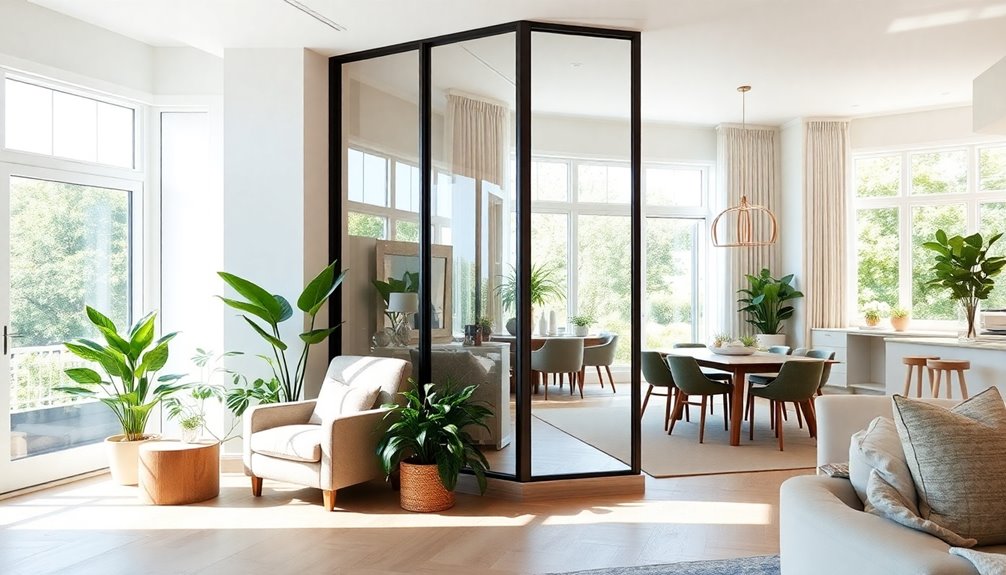
In designing multigenerational homes, you'll want to create private living spaces that allow everyone to feel independent.
Soundproofing shared areas can help maintain quietness, giving family members the peace they need.
Plus, flexible room configurations can easily adapt to changing needs, ensuring everyone has their own sanctuary.
Private Living Spaces
Creating private living spaces in a multigenerational home is essential for fostering both independence and privacy among family members.
Consider incorporating separate bedroom suites that provide personal retreats, allowing everyone to unwind. Multiple entrances facilitate easy access, promoting autonomy while still encouraging family interaction.
Accessibility features, like curbless showers and comfort height toilets, guarantee that these private living spaces are safe and comfortable for all ages.
Additionally, think about flexible living space layouts that allow you to close off or reconfigure rooms as needed.
This adaptability helps in transforming these spaces to meet changing family dynamics over time, assuring everyone has their own sanctuary while maintaining a harmonious environment. Furthermore, incorporating proper insulation can enhance thermal comfort, ensuring that private spaces remain energy-efficient and cozy throughout the year.
Soundproofing for Quietness
Designing private living spaces sets the stage for incorporating soundproofing measures that further enhance comfort and independence in a multigenerational home.
By using acoustic panels and noise-deafening fabrics, you can considerably reduce sound transfer between living areas, boosting privacy. Guarantee well-insulated doors and windows in entertainment zones to minimize disruptions, allowing family members to enjoy activities without bothering others.
Strategically placed carpets and rugs absorb sound while preventing trip hazards. Consider separate entrances for different living quarters, promoting independence and privacy.
Regularly assess noise levels in shared spaces to maintain a peaceful environment, guaranteeing everyone feels comfortable and at ease in their home. Additionally, implementing regular cleaning of air purifiers can help maintain a tranquil atmosphere by ensuring optimal air quality throughout the house.
With these strategies, you'll create a harmonious living experience for all generations.
Flexible Room Configurations
While balancing communal living with personal space can be challenging, flexible room configurations offer a practical solution for multigenerational homes.
By designing adaptable spaces, you can guarantee that family members enjoy their independence while remaining part of a shared environment.
Consider these strategies:
- Movable Partitions: Use sliding doors or screens in shared areas to create private zones when needed.
- Multifunctional Rooms: Design spaces that can serve multiple purposes, such as a den that doubles as an office or guest room.
- Separate Entrances: Incorporate layouts with distinct entrances or suites to maintain independence for older family members while still allowing for communal interactions.
These approaches make creating spaces that foster both privacy and togetherness seamless. Additionally, incorporating financial planning into the design process can help families manage the costs associated with maintaining a multigenerational home.
Creating Flexible and Adaptable Spaces
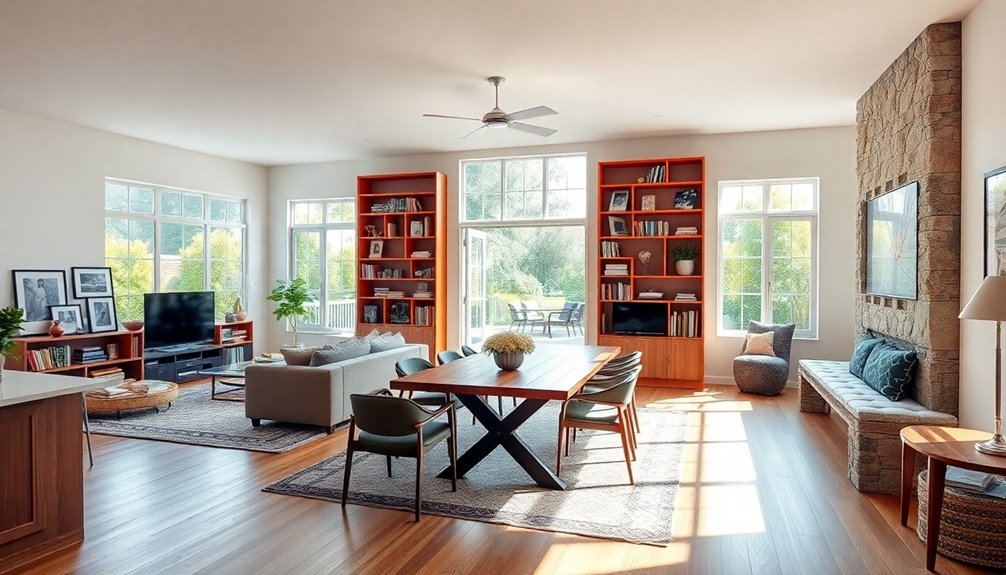
As families evolve, spaces that can adapt to shifting needs become essential in multigenerational homes. Designing flexible rooms allows for multi-use spaces that cater to evolving needs, such as home offices that double as guest rooms. Incorporating adaptable furniture like sofa beds and expandable tables maximizes functionality, making everyday life and special gatherings more manageable. Additionally, creating defined areas for different types of play and learning can support advanced babies and enhance family interactions.
| Feature | Benefits | Examples |
|---|---|---|
| Flexible Rooms | Accommodate changing needs | Multi-use living areas |
| Adaptable Furniture | Maximize space and utility | Sofa beds, expandable tables |
| Separate Entrances | Enhance privacy and comfort | Independent access points |
With these strategies, you'll create a harmonious environment where everyone can coexist comfortably.
Ensuring Accessibility and Safety Features
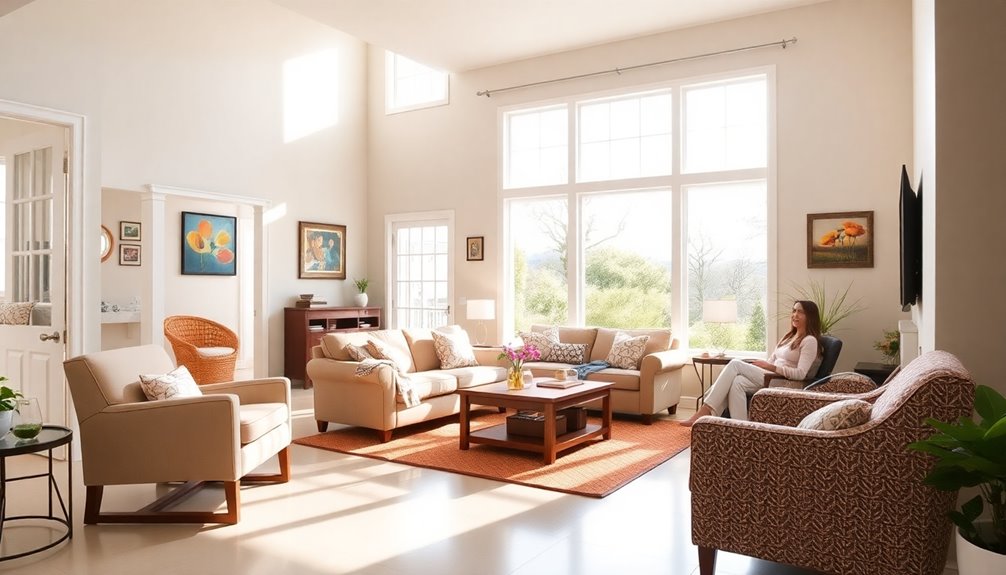
To create a safe and welcoming environment in multigenerational homes, it's vital to incorporate accessibility features that cater to all age groups.
These enhancements not only promote safety but also accommodate those facing mobility challenges. Here are three essential features to take into account:
- Grab bars and comfort height toilets: They enhance safety in bathrooms, reducing fall risks for seniors and making facilities user-friendly for everyone.
- Curbless showers: They provide easy access for both bathers and caregivers, fostering independence for those with mobility issues.
- Zero-step entries: These facilitate seamless access for wheelchairs and strollers, ensuring all family members feel welcome.
Importance of Noise Control and Acoustic Design
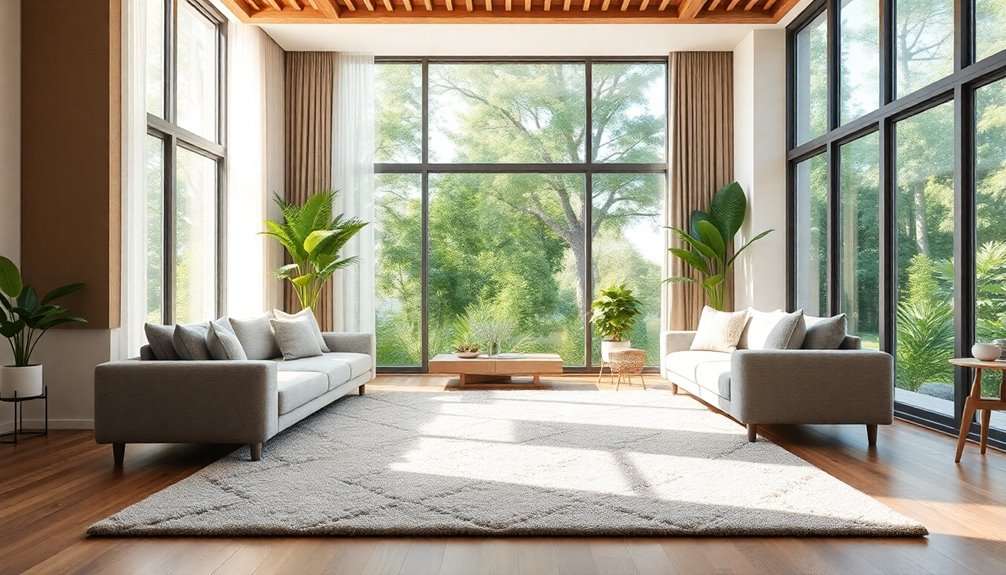
Noise control plays an essential role in creating a harmonious atmosphere in multigenerational homes, where varying lifestyles and schedules can lead to potential conflicts. Excessive noise can cause stress and discomfort, so incorporating acoustic treatments is vital.
You can use noise-deafening fabrics for window treatments, wall coverings, and flooring to greatly reduce sound transmission in living areas. Additionally, installing well-insulated doors in entertainment spaces helps contain sound, preserving privacy during simultaneous activities.
Regularly evaluating noise levels guarantees communal spaces remain inviting while providing quiet zones for relaxation. By integrating soundproof panels and rugs, you'll enhance the overall quality of life for all family members, promoting peace and comfort in your home.
Incorporating Outdoor Spaces for Connection
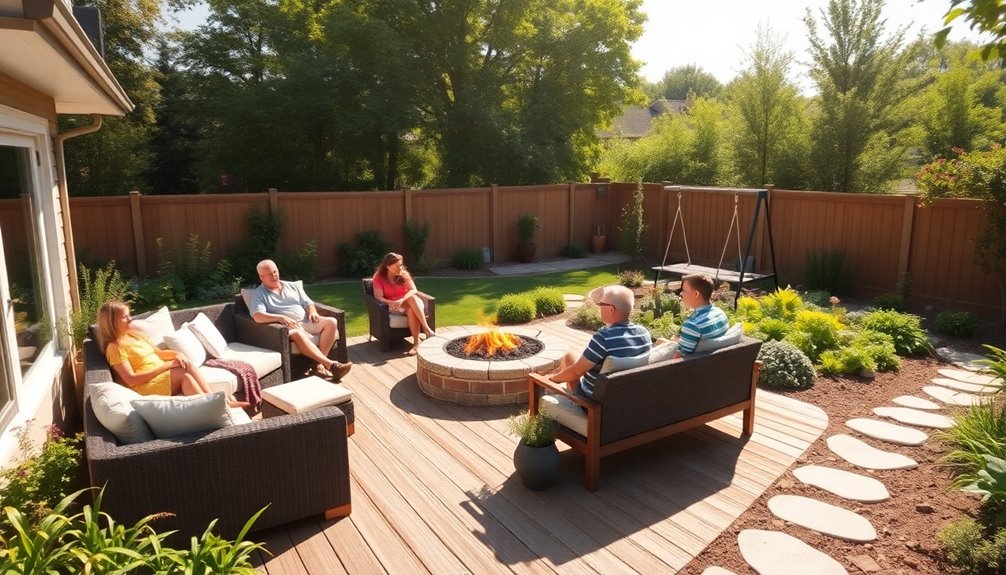
Creating outdoor spaces can greatly enhance connections among family members in multigenerational homes. These areas foster engagement through shared activities, allowing everyone to bond over gardening, barbecues, or playtime. By incorporating comfortable seating, vibrant plants, and playful features, families can transform your backyard space into a welcoming environment for all ages. Such an atmosphere not only promotes interaction but also encourages the creation of lasting memories. Whether it’s celebrating birthdays or simply enjoying a quiet evening under the stars, these outdoor settings provide the perfect backdrop for strengthening relationships within the household.
Here are three effective strategies to design your outdoor spaces:
- Design Accessible Pathways: Guarantee all family members can easily navigate the area, making it enjoyable for both young children and older adults.
- Create Designated Activity Zones: Establish areas for play, relaxation, and dining, catering to diverse interests and promoting interaction.
- Incorporate Natural Elements: Use native plants and water features to create a calming environment that enhances mental well-being and encourages outdoor engagement. Additionally, consider integrating sustainable materials to further enrich the outdoor experience and support eco-friendly practices.
Personalizing Areas for Individual Needs
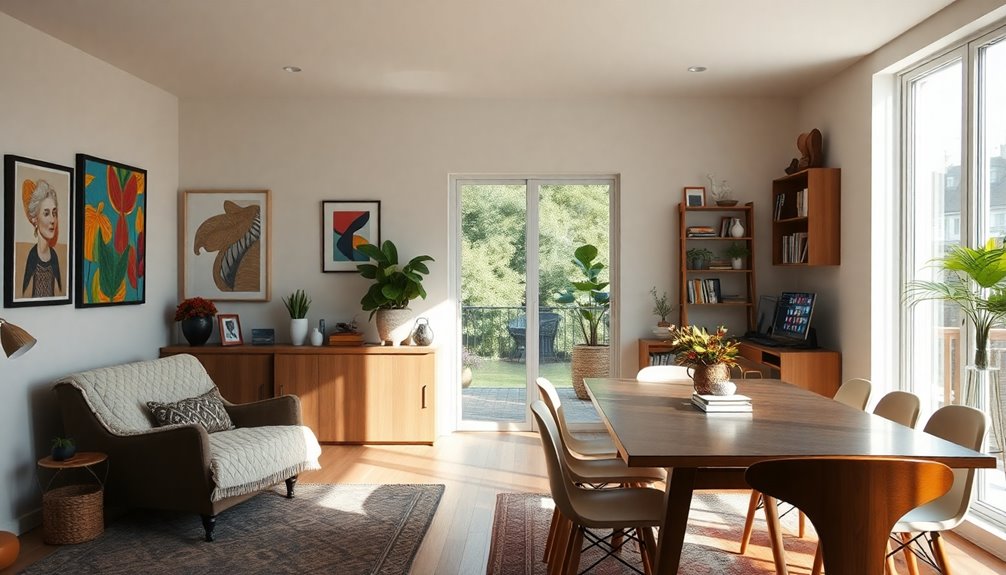
Personalizing areas for individual needs can transform your multigenerational home into a haven of comfort and belonging.
By incorporating tailored living spaces and unique decor choices, each family member can feel a sense of ownership and identity.
Creating personal comfort zones not only enhances well-being but also fosters harmony among generations. Additionally, utilizing modern farmhouse style elements can create inviting and functional spaces that appeal to all ages.
Tailored Living Spaces
While living together in a multigenerational home can foster connection, tailoring living spaces to meet individual needs is essential for maintaining harmony and comfort.
By creating tailored living spaces, you enhance personal comfort and satisfaction for everyone.
Consider these strategies:
- Separate Bedroom Suites: Offer privacy and independence, allowing family members to retreat to their own spaces.
- Flexible Rooms: Design adaptable areas that can transform based on changing needs, like converting a craft room into a guest suite.
- Accessibility Features: Implement smart home technology and safety enhancements, such as grab bars and curbless showers, ensuring comfort for older family members or those with mobility challenges.
Incorporating essential oils for relaxation can also create a soothing atmosphere that benefits everyone in the home.
These thoughtful choices can greatly improve the living experience for everyone involved.
Individual Decor Choices
When family members have the freedom to express their identities through individual decor choices, the home becomes a more vibrant and welcoming space.
Personalizing bedrooms with distinct themes or color palettes not only reflects personal tastes but also fosters a sense of ownership and belonging.
Incorporating smart home technology allows everyone to control lighting and temperature, tailoring their living experience to individual preferences.
Sensory-friendly materials can create calming atmospheres, especially for neurodivergent family members, reducing overstimulation.
By allowing personal decor choices in private areas, you respect individual boundaries while enhancing the overall harmony of a multigenerational home.
Celebrating diversity within your shared living environment makes it a more inclusive and enjoyable place for everyone.
Personal Comfort Zones
Creating a welcoming atmosphere in a multigenerational home involves more than just individual decor choices; it also means establishing personal comfort zones tailored to each family member's needs.
Here are three key strategies to enhance comfort:
- Individual Bedrooms: Design rooms that reflect each person's style, ensuring they feel a sense of ownership and privacy.
- Flexible Spaces: Incorporate areas like a den or craft room where family members can unwind or engage in hobbies, accommodating diverse interests.
- Smart Home Technology: Utilize tech to control lighting, temperature, and ambiance, allowing each space to adapt to varying preferences across generations.
Efficient Kitchen Design for Larger Households
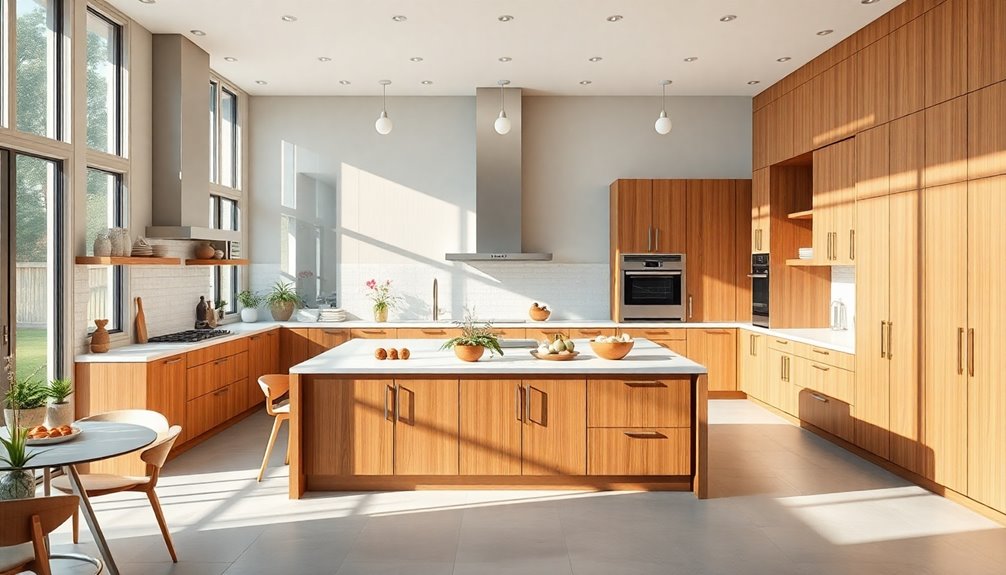
A well-designed kitchen can make all the difference for larger households, transforming meal prep into an efficient and enjoyable experience.
Focus on an efficient kitchen design that incorporates a functional work triangle—linking the refrigerator, sink, and cooktop—to optimize your workflow.
With adequate food storage, consider multiple pantries or cabinets to meet the needs of your multi-generational family.
Creating multiple food prep zones allows for simultaneous cooking, making it easier to handle meals for gatherings or daily dinners.
Guarantee convenient access from dining areas and entrances for smooth food serving and cleanup.
While size isn't everything, thoughtful layouts and accessibility features are essential, catering to all family members, including those with mobility challenges.
Establishing Open Communication Among Family Members
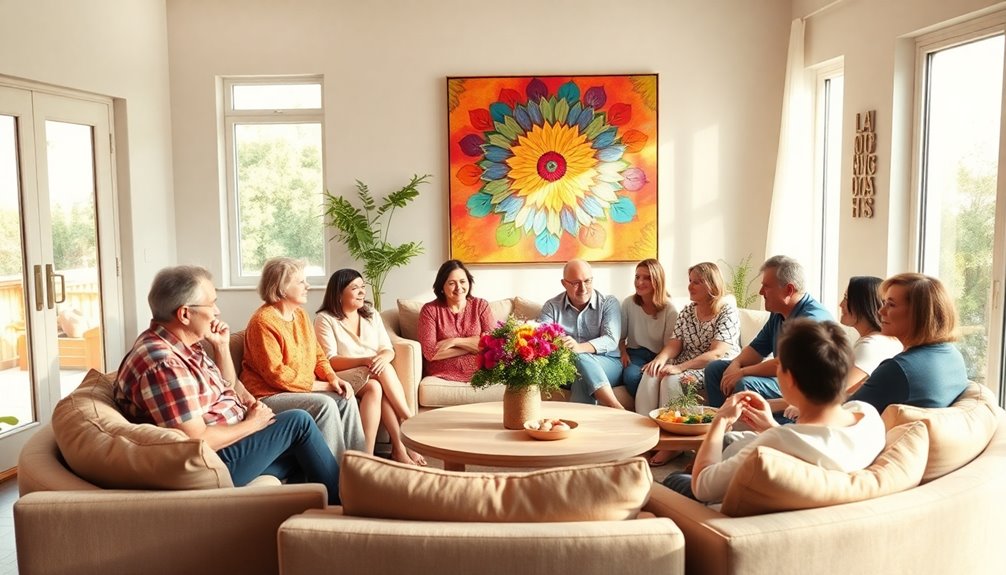
Establishing open communication is essential for successful multigenerational living, as it helps everyone navigate the complexities that arise in shared spaces.
When you foster clear and respectful communication, you'll likely notice improved relationships among family members.
Consider these strategies:
- Regular Family Meetings: Hold discussions to address concerns and share responsibilities, making everyone feel heard.
- Set Boundaries: Discuss personal space expectations early on to prevent misunderstandings and promote privacy in shared living arrangements.
- Utilize Digital Tools: Use shared calendars and task lists to keep everyone informed and accountable for household duties.
Encouraging an open-door policy for feelings and concerns will strengthen emotional bonds, creating a supportive atmosphere that benefits all generations under one roof.
Frequently Asked Questions
What Is the Best Layout for a Multigenerational Home?
When considering the best layout for a multigenerational home, focus on creating separate living quarters that provide privacy for each family member.
Incorporate multiple entrances to enhance accessibility and allow for easy movement.
Design communal spaces, like kitchens and family rooms, to be centrally located, encouraging interaction.
Also, think about flexible spaces that can adapt over time, ensuring your home meets changing needs while remaining functional for everyone in the household.
How to Make Multigenerational Homes Work?
To make multigenerational homes work, start by establishing clear communication among family members.
Define personal spaces for privacy and downtime, ensuring everyone feels comfortable.
Share household chores equitably to foster a sense of responsibility and prevent resentment.
Engage in transparent financial planning to avoid misunderstandings about contributions.
Finally, cultivate mutual respect by acknowledging each other's boundaries, which is essential for maintaining harmony in a shared living environment.
What Are the Disadvantages of a Multigenerational Household?
Have you ever felt overwhelmed by too many people under one roof? In a multigenerational household, privacy can be scarce, leading to conflicts.
Financial disagreements often arise, making tensions flare. You might find lifestyle habits clash, creating discomfort among family members.
Caregiving responsibilities can burden one generation, while younger members might struggle with independence, stunting their growth.
These disadvantages can challenge the harmony you seek in shared living arrangements.
How Can You Best Describe Multigenerational Households?
You can best describe multigenerational households as dynamic living environments where multiple generations coexist, sharing both space and responsibilities.
These homes blend the lifestyles of children, parents, and grandparents, fostering strong emotional connections and support systems.
You'll find that they promote financial efficiency, as family members share expenses, while also allowing for a balance between privacy and togetherness.
Ultimately, they create a nurturing atmosphere that benefits everyone involved.
Conclusion
Incorporating these design strategies will help you create a harmonious multigenerational home that meets everyone's needs. Did you know that nearly 20% of Americans live in multigenerational households? By focusing on privacy, adaptability, and personal touches, you can foster a space where family members of all ages thrive together. Embrace the joy of shared living while ensuring everyone has their own comfortable haven. With thoughtful design, your home can truly become a sanctuary for all.
